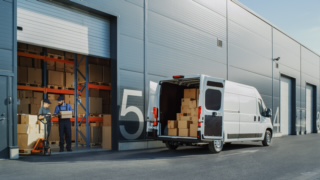Running a fleet is expensive. It involves maintenance checks, repairs, efficiency, driver wages and welfare, fuel costs, and more.
Fuel costs are the highest expense and make up 30% of your total fleet operating costs. According to The Trucker’s Report, commercial trucks consume at least 40 times more fuel than passenger vehicles. This is a major outgoing expense. Whether your fleet consists of trucks, buses, HGVs, or cars, the soaring cost of diesel rippling through the global economy is affecting all fleet businesses.
You can’t control fluctuating fuel prices, but what if you can monitor usage, and manage things like idling time and aggressive driving, both of which have an impact on expenses? Did you know that aggressive driving can affect fuel economy by an average of 31%?
Fuel consumption can be measured and tracked. Here are some things to think about when calculating fuel costs as a fleet manager:
- Do you know how much each vehicle consumes on average?
- Do you know how far your vehicles travel?
- Do you know your fixed costs per vehicle? This includes insurance, registration, road tolls, rent, etc.
- Are your drivers fully trained and operating their vehicles as efficiently as possible?
If you don’t want to experience revenue losses, it’s time to review and analyze your fuel consumption control and implement strict management: every lost or wasted liter means fewer digits on your bottom line.

What are the main drains?
At what stages of the operation do losses and/or deviations occur? The answer is all of them. Starting with transport and delivery.
1 – Delivery
Between filling the tanker truck at the fuel depot, and storage in the site’s tank, some irregular events may occur. Examples include, fuel leakage, unauthorized dispensing on the way (fraud) and temperature losses. These deviations are not included in the invoice and are not identified by manual fuel monitoring systems of tanker trucks. However, these are potentially correctable losses.
Because of events like these, payment for the fuel is higher than the volume that is delivered to the site’s tank. This is the difference between the theoretical and actual inventory. You pay, but you don’t use everything you’ve purchased.
In addition, due to inaccuracies of the amount of fuel in the tanker truck, overflow can occur during unloading. This compound losses, as well as add to the risk of contamination of the environment which can bring about legal sanctions, all of which also become financial losses.
On the other hand, the ignorance about the correct level of stock in the tank can lead to fuel running out before the expected deadline, causing possible delays in your work schedule and other additional costs. This may result in the company resorting to a commercial fuel reseller site, where prices are higher due to aggregate margins, higher tax burdens, and requirements of immediate payment. Why disrupt the workflow and still have to pay extra when you’ve already invested in a structure of your own? Why not maintain your fleet’s fuel supply at a lower fuel expense than can be found in a retail station?
2 – Storage
Storage presents additional potential points of loss in leaks and volume fluctuation caused by fuel temperature changes.
Leaks can occur both in above or underground tanks, and in pipes. These fuel leaks create losses, generate risks, and the manager is often unaware of their existence. Leaks are caused by lack of adequate protection of equipment that are produced with materials subject to corrosion. They occur when the equipment is exposed to weather and accidents, or, in the case of underground tanks, due to deterioration from moisture and soil. The absence of effective tank and pipe measurement systems that instantly detect leaks, prevents the problem from being identified and quickly remedied.
Temperature is another factor that influences fuel storage. Temperature can affect the volume of liquid, and cause it to expand or contract, resulting in variations in the height of the fuel dipstick. Manual measurements do not consider the influence of this variable on inventory measurement and can create inaccurate readings in the tank.
3 – Fueling
Fueling is another potential point of loss. Uncalibrated or manipulated pumps, overflow when fuelling a vehicle, and various types of misuse are a few of the issues that cause losses. These losses are not easily accounted for and are even perceived as faulty management of product information.
The lack of regular measurement of the pump and the incorrect handling of its components, such as the hoses and nozzles, often performed by careless employees or those who did not receive proper training, can also lead to fuel waste.
What about maintenance costs? Installations with old mechanical pumps are common, and require frequent maintenance and calibration in addition to the increase in operational expenses of the stations. Are readings from these facilities really reliable?
4 – Information management
We are all human, and mistakes are a forgone conclusion. A small error in collecting data from fueling when filling out a spreadsheet is enough to generate incorrect reports. The same applies to the fueling registration, whether by mistake or bad faith, regarding unauthorized vehicles.
Human failures can also occur in measuring fuel tank inventory, causing overflow or lower volume deliveries than those mentioned of in the invoice. Often, the fueling point manager cannot focus their attention solely on this task because they perform other functions at the same time. Thus, the information in these spreadsheets is often unreliable.
Do you really know how much fuel you received on your last delivery, or what the volume in the fuel tank is at any given moment? Do you know when to schedule a new delivery, or how many times vehicles refueled each month, by which vehicles, in what quantity and on which days? Can you track what is the average monthly consumption of each vehicle in the fleet? More importantly, can you be certain that the volume of fuel you purchased that month is equal to the volume consumed by the fleet?
The result of all information failures is the inability to obtain reliable, useful data. Solving this allows for greater efficiency in fuel management, and in turn greater savings and productivity for your business. Efficiency requires the ability to rely on your business data, offering full control of your fleet’s fuel consumption. There are solutions that can be implemented.
The value of losses
Given the current price of fuel and the forecasts of price increase throughout 2022 and into 2023, it is essential to efficiently manage this expenditure.
Car owners in the United States have been shocked by fuel prices of more than $4/gallon, but there has been an even bigger increase in the price of diesel, which plays a critical role in the global economy because it powers so many different kinds of vehicles and equipment. A gallon of diesel is selling for an average of $5.19 in the United States, according to government figures, up from $3.61 in January. In Germany, the retail price has shot up to €2.15 /liter, up from €1.66 at the end of February, according to ADAC.
Fuelling stations in Argentina have begun rationing diesel, jeopardizing one of the world’s leading agricultural economies, and energy analysts warn that the same could soon happen in Europe.
The sharp jump is putting immense pressure on trucking firms, especially smaller operations.
In Germany, for example, with diesel delivered at a cost of €2.15 /liter to a site that consumes 350,000 liters per month. The monthly expense would be €752,500.00. However, with inefficient management, part of this fuel, about 5%, disappeared along the way, although the total expenditure was accounted for. This means a loss of 17,500 liters, or €37,625.00.
But, according to experts, these losses can frequently reach 10% of the total stock, which equates to €75,250.00!
Orpak can help. Our flexible, end-to-end site control and management solutions are suited to any C&I fleet’s business requirements, whatever the activity, business size or specific need. Talk to us and we will find the best suited solution for your business.


